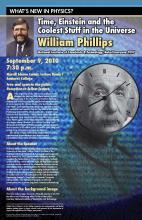By Katherine Duke '05
The 1997 Nobel Laureate in Physics does not eat his pizza crusts. I made this observation on Thursday, Sept. 9, when William Phillips dropped by the Physics Student Lounge in Merrill Science Center to have lunch with some Amherst students.
 A poster for one of William Phillips' recent lectures at Amherst |
Phillips (along with Steven Chu and Claude Cohen-Tannoudji) won the Nobel for contributions to the development of a technique called laser cooling, in which scientists direct laser beams onto atoms in order to slow the atoms down so that they are easier to study and use. He now leads the Laser Cooling and Trapping Group in the Physics Laboratory at the National Institute of Standards and Technology (NIST) in Gaithersburg, Md. Phillips was at Amherst last week to give a seminar, titled “Spinning Atoms with Light: A New Twist on Coherent de Broglie-Wave Optics,” and later a talk on “Time, Einstein and the Coolest Stuff in the Universe” (part of the Five College Colloquium on “What’s New in Physics?”).
In between these events, there was a gathering for pizza and soda—and questions and answers. Phillips arrived in the lounge wearing a necktie decorated with planets and stars. He opened the discussion with a favorite quotation from J.R.R. Tolkien’s The Fellowship of the Ring: “Go not to the elves for counsel, for they will say both ‘Yes’ and ‘No.’” The scientist warned, “That’s often the kind of answer I give.”
But he urged the students—mostly physics majors—not to be shy or reluctant to ask questions. “I think that one of my strengths is that I have no shame,” he said. “I tend to ask questions that might seem stupid, but what I find is that people are very grateful that I’ve asked those questions that they were afraid to ask.” He added, “And usually you’ll find that questions that appear to be very simple, in fact, are often a lot deeper.”
Phillips offered an additional incentive to anyone who would ask a question: a wallet-sized card from the NIST, listing the institute’s latest adjustments to the fundamental constants. “Every physicist should have the fundamental constants in their wallet,” he said. “So, the first n people who ask me a question will get one, where n is the number of cards that I happen to have.”
Many students did raise their hands, and Phillips drew diagrams on the blackboard as he answered their questions about several different ways in which laser cooling can be used to “trap” atoms. He described how laser cooling has allowed for more and more advanced atomic clocks—the most accurate timekeeping devices in the world. One student asked whether Phillips works with the super-cold substances known as Bose-Einstein condensates—as do Amherst Professor David Hall and his student research assistants. Phillips said that his group has worked with the condensates, but that they use them to create different kinds of vortices than those made in Amherst’s labs. Eventually, the conversation turned to quantum computing (the use of the quantum behavior of individual molecules to perform operations on data): specifically, its potential to allow for calculations that are far beyond the capacities of today’s computers and its implications for the future of computer security. As someone who has never taken a physics class in my life, I was pleasantly surprised that much of what the Nobel laureate was saying was not sailing hopelessly over my head.
One by one, the students thanked the special guest and trickled out of the lounge, to get to their next classes. Phillips stayed behind to help solve one last physics problem: how best to stack and dispose of the empty pizza boxes.